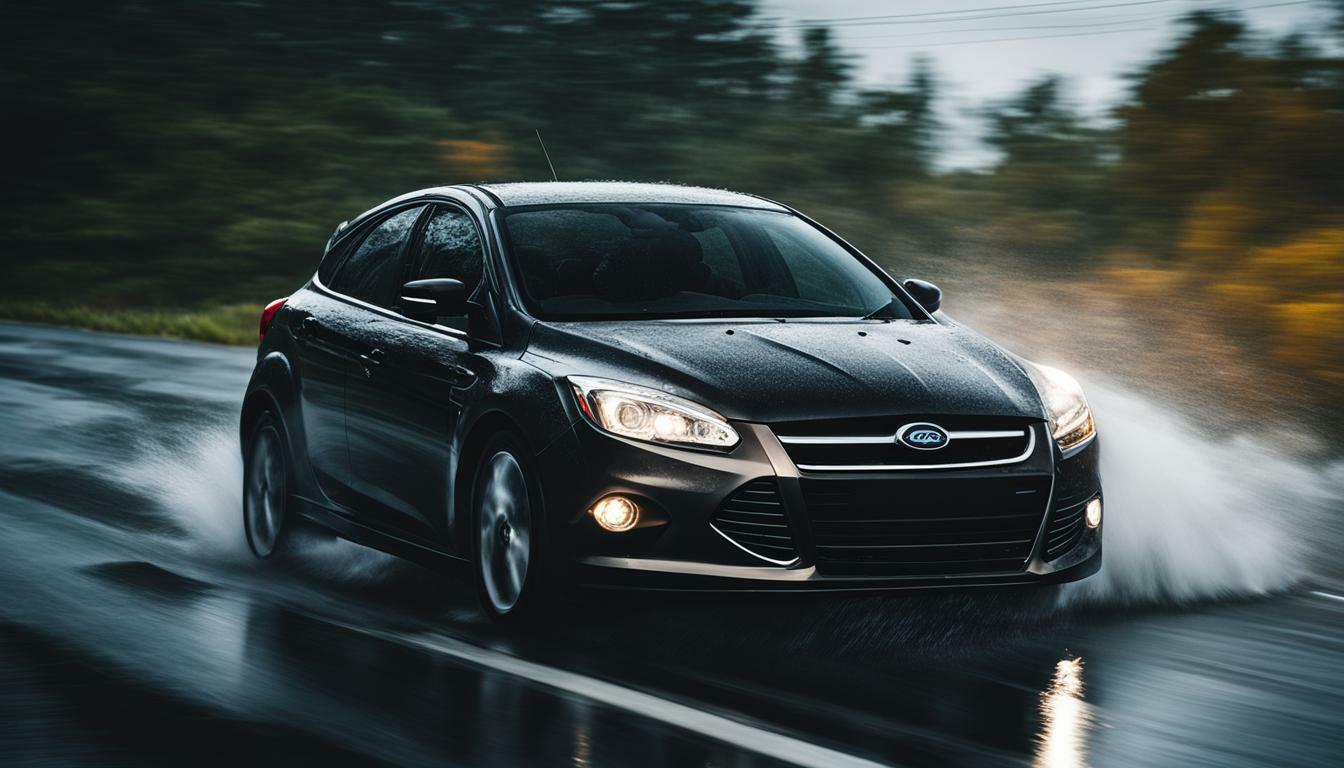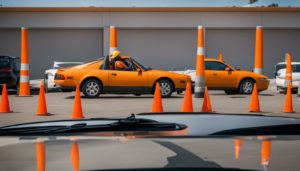Are you prepared to drive in rainy weather? Follow these essential tips to ensure a safe and confident journey.
- Wait Until the Weather Improves if Possible: If you can postpone your trip or commute, it's best to wait until the rain stops.
- Double Check Your Car's Equipment: Make sure your headlights, tail lights, and windshield wipers are working properly. Also, ensure that your tires have enough tread for good traction.
- Slow Down: Reduce your speed and drive slower than usual in wet conditions. Wet roads can be slippery, so it's important to allow for a longer reaction time.
- Turn On Your Headlights: Turn on your headlights to improve visibility for yourself and other drivers.
- Use Your Windshield Wipers: Don't forget to turn on your windshield wipers to clear moisture from the glass. Replace them if they are making noise or not working effectively.
By following these tips, you can stay safe while driving in the rain. Remember to reduce your speed, increase your distance from other cars, and use your headlights and windshield wipers for better visibility.
Wait Until the Weather Improves if Possible
If the rain is pouring down, consider waiting until the weather improves before hitting the road. Driving in rainy weather can be challenging and hazardous, so it's best to prioritize safety. Waiting for better weather conditions can significantly reduce the risks associated with driving in the rain.
According to experts, wet roads can be slippery, making it more difficult to control your vehicle. This is especially true during heavy rainfall when visibility is reduced. By waiting for the rain to subside, you can avoid potentially dangerous situations and ensure a safer journey.
Additionally, waiting for the weather to improve allows time for rainwater to drain away, reducing the risk of encountering standing water on the roads. Standing water can cause hydroplaning, a dangerous situation where your tires lose contact with the road surface, leading to a loss of control. By giving the water time to dissipate, you can minimize the chances of hydroplaning and navigate the roads more safely.
Remember, it's always better to exercise caution and wait until the weather conditions are more favorable before embarking on your journey. Prioritizing safety and adopting defensive driving techniques are essential when facing rainy weather conditions. By following these guidelines, you can ensure a smoother and less risky experience on the road.
Double Check Your Car’s Equipment
Before driving in the rain, make sure your car's equipment is in top-notch condition. This includes checking your headlights, tail lights, and windshield wipers. Good visibility is essential in wet conditions, so make sure all your lights are working properly. If any bulbs are burnt out, replace them before hitting the road. Additionally, test your windshield wipers to ensure they effectively clear moisture from the glass. If they are making noise or leaving streaks, it's time to replace them.
To ensure optimal safety while driving in wet conditions, it's vital to have good traction on the road. Check the tread on your tires to make sure they have enough grip. Worn-out tires can significantly increase the risk of skidding or hydroplaning. If the tread is worn down, consider replacing your tires before venturing out into rainy weather. Remember, having proper tire traction is crucial for maintaining control of your vehicle on wet roads.
Table: Car Equipment Checklist
| Car Equipment | Checklist |
|---|---|
| Headlights | Ensure all bulbs are working |
| Tail lights | Ensure all bulbs are working |
| Windshield wipers | Test functionality and replace if necessary |
| Tires | Check tread depth and consider replacement if necessary |
Quote: “Having properly functioning car equipment is essential for safe driving in wet conditions. It's always better to be proactive and take the time to check your headlights, tail lights, windshield wipers, and tires before heading out in the rain.” – Me
Summing Up Car Equipment Safety Checks
- Check your headlights, tail lights, and windshield wipers for proper functionality.
- Replace any bulbs that are burnt out.
- Ensure your windshield wipers effectively clear moisture from the glass.
- Inspect your tires for adequate tread depth and consider replacing them if necessary.
By double-checking your car's equipment and ensuring everything is in working order, you can minimize the risks associated with driving in wet conditions. Remember, taking these precautions is essential for your safety and the safety of others on the road.
Slow Down
When rain hits, it's crucial to slow down and adjust your driving speed for the wet roads. Wet surfaces can become extremely slippery, making it harder to maintain control of your vehicle. By reducing your speed, you give yourself more time to react to sudden changes in road conditions and other drivers' actions.
One effective way to control your speed in wet weather is to release the accelerator early rather than braking abruptly. This gradual approach allows the weight of the car to shift naturally, reducing the risk of skidding or losing traction. It's important to avoid using cruise control in wet conditions, as it can interfere with your ability to react quickly.
By driving slower than usual, you not only increase your own safety but also create a safer environment for other drivers. Remember to keep a greater distance between your vehicle and the car in front of you. This extra space allows for a longer stopping distance, giving you more time to brake gently and avoid collisions.
Staying Cautious on Wet Roads
Along with slowing down, it's essential to stay vigilant and adjust your driving techniques in wet conditions. Remember to avoid sudden turns or braking when hydroplaning occurs. Instead, calmly take your foot off the accelerator and steer in the direction you want to go. This gentle approach helps regain control of the vehicle and minimizes the risk of potential accidents.
Furthermore, don't forget to turn on your headlights and use your windshield wipers effectively. These actions improve visibility, making it easier for you to see the road ahead and for other drivers to see you. If your windshield wipers are making noise or not clearing the moisture effectively, it's advisable to replace them to ensure optimal visibility in rainy weather.
| Driving Tips for Rainy Weather |
|---|
| Slow down and adjust your driving speed for wet roads. |
| Release the accelerator early instead of braking abruptly to avoid skidding. |
| Keep a greater distance between your vehicle and the car in front of you. |
| Avoid sudden turns or braking when hydroplaning. |
| Turn on your headlights and use your windshield wipers effectively for better visibility. |
By following these wet weather driving tips, you can navigate the rain safely and minimize the chances of accidents or skidding. Remember, reducing your speed, increasing the distance from other cars, and ensuring clear visibility are key to driving safely in rainy weather.
Turn On Your Headlights and Use Your Windshield Wipers
To enhance visibility in the rain, remember to turn on your headlights and use your windshield wipers. These two simple actions can make a big difference in your ability to see the road clearly and be seen by other drivers. When rain starts falling, it's crucial to activate your headlights, even if it's still daylight. This helps illuminate the road ahead and makes your vehicle more visible to others.
Using your windshield wipers is equally important. They help clear away rainwater and keep the windshield clear, ensuring that your vision is not obstructed. Be sure to replace your wiper blades regularly if they are worn or making noise, as this can affect their effectiveness. Properly functioning headlights and windshield wipers are essential for safe driving in wet conditions.
Remember, your headlights and wipers are not just for heavy rain, but also for light drizzles that can still impair visibility. Don't wait until it's pouring to turn them on. Be proactive and keep yourself and others safe by using these vital tools. By doing so, you'll have a clearer view of the road, reducing the chances of accidents and promoting a safer driving experience for everyone.
Maintain a Safe Distance Between Cars and Avoid Heavy Braking
Keep a safe distance from the car ahead and avoid heavy braking to prevent accidents on slippery roads. Driving in wet conditions requires extra caution, as roads can become slick and reduce your vehicle's ability to stop quickly. By maintaining a safe distance between cars, you provide yourself with ample time to react to any sudden changes or emergencies that may arise.
When following other vehicles in the rain, it's important to increase the distance between you and the car in front. The general rule of thumb is to stay at least three seconds behind, which gives you enough space to stop safely if the car in front suddenly brakes. In case of heavy rain or low visibility, it's recommended to extend the following distance even further.
Instead of relying on heavy braking, gradually release the accelerator early when approaching a stop sign, traffic light, or any other situation that requires you to slow down. This helps avoid sudden and abrupt stops, reducing the risk of skidding or losing control of your vehicle. Additionally, avoid using cruise control in wet conditions, as it may not react as quickly or effectively as you would when manually controlling your car's speed.
Remember, the key to safe driving in wet conditions is to anticipate and react early. By maintaining a safe distance between cars and avoiding heavy braking, you significantly reduce the chances of accidents on slippery roads.
| Tips for Maintaining Safe Distance Between Cars and Avoiding Heavy Braking |
|---|
| Increase your following distance to at least three seconds in wet conditions. |
| Extend the following distance in heavy rain or low visibility. |
| Release the accelerator early instead of relying on heavy braking. |
| Avoid using cruise control in wet conditions. |
By following these tips, you can ensure a safer driving experience in wet conditions. Remember, it's better to be cautious and take preventive measures to avoid accidents, rather than risking your safety and the safety of others on the road.
Watch Out For Standing Water and Hydroplaning
Be cautious of standing water and take measures to avoid hydroplaning, which can be hazardous in rainy conditions. When water accumulates on the road surface, it reduces the tire's contact with the road, leading to a loss of traction. This can cause your vehicle to slide or skid out of control, posing a serious risk to your safety.
To stay safe, it's essential to be aware of how to navigate through standing water and prevent hydroplaning. Here are some tips:
- Reduce your speed even further when there is standing water on the road. This will help to minimize the chances of hydroplaning as your tires make contact with the road surface.
- Stay away from puddles and areas of standing water if possible. If you encounter standing water, try to steer around it or change lanes to avoid driving through it directly.
- Avoid sudden turns, braking, or acceleration when driving through wet patches. These abrupt motions can increase the risk of hydroplaning. Instead, maintain a steady speed and gentle steering movements.
Remember that hydroplaning can occur even at lower speeds, so it's vital to stay vigilant and adapt your driving behavior to the road conditions. If you do find yourself hydroplaning, remain calm and follow these steps:
- Take your foot off the accelerator pedal to allow the tires to regain traction.
- Keep both hands on the steering wheel and steer in the direction you want to go. Avoid making sudden or sharp turns that could cause you to lose control.
- Don't slam on the brakes, as this can worsen the skid. Instead, gently apply the brakes once you feel the tires grip the road again.
Always be cautious and stay focused on the road when driving in rainy weather. By following these tips and being mindful of standing water, you can help ensure a safer and more comfortable journey.
| Tip | Summary |
|---|---|
| Reduce Speed | Slow down to minimize the risk of hydroplaning. |
| Avoid Standing Water | Steer around puddles or change lanes to avoid driving through standing water. |
| Smooth Movements | Avoid sudden turns, braking, or acceleration to maintain control. |
| Foot off the Accelerator | Release the accelerator pedal to allow the tires to regain traction. |
| Steer in the Desired Direction | Keep both hands on the wheel and steer towards where you want to go. |
| Brake Gently | Apply the brakes gently once the tires regain traction. |
Conclusion
By following these tips, you can navigate rainy weather like a pro and ensure your safety on the road. Driving in rain can be challenging, but taking precautions is key to avoiding accidents and maintaining control of your vehicle.
First and foremost, if possible, it's best to wait until the weather improves before hitting the road. This allows for better visibility and reduces the risk of hydroplaning.
Before embarking on your journey, double check that your car's equipment is in good working order. Ensure that your headlights, tail lights, and windshield wipers are functioning properly. Additionally, make sure your tires have enough tread for optimal traction.
When driving in rainy conditions, remember to reduce your speed and drive slower than usual. Wet roads can be slippery, so it's important to allow for a longer reaction time. Turning on your headlights and using your windshield wipers effectively will improve visibility for yourself and other drivers.
Maintaining a safe distance between cars is crucial. Keep a greater distance between your vehicle and the one in front of you to allow for a longer stopping distance in case of an emergency. Additionally, avoid heavy braking and release the accelerator early to slow down.
Watch out for standing water on the road, as it can cause hydroplaning. If you encounter standing water, steer around it or change lanes. If you start hydroplaning, calmly take your foot off the accelerator and steer in the direction you want to go.
To prevent foggy windows, ventilate your car by using the ventilation system or cracking a window to lower the temperature. This will help maintain clear visibility.
Remember, by following these tips, you can stay safe while driving in the rain. Reduce your speed, increase your distance from other cars, and use your headlights and windshield wipers for better visibility. Stay cautious and enjoy a smooth ride even in wet weather conditions!
FAQ
When should I drive in the rain?
It's best to wait until the rain stops if you can. Driving in rain can be challenging and dangerous, so it's important to prioritize safety.
What should I check on my car before driving in the rain?
Double check that your headlights, tail lights, and windshield wipers are working properly. Also, ensure that your tires have enough tread for good traction.
Why should I slow down when driving in the rain?
Wet roads can be slippery, so it's important to reduce your speed and drive slower than usual. This allows for a longer reaction time and improves safety.
Should I turn on my headlights and windshield wipers when it’s raining?
Absolutely! Turning on your headlights improves visibility for yourself and other drivers. Don't forget to also turn on your windshield wipers to clear moisture from the glass.
How should I maintain a safe distance between cars in the rain?
Keep a greater distance between your vehicle and the car in front of you. This will provide more stopping distance in case of an emergency and reduce the risk of collision.
Why should I watch out for standing water while driving in the rain?
Standing water can cause hydroplaning, which is when your tires lose contact with the road surface. It's important to avoid driving through standing water to prevent loss of control.
What should I do if I start hydroplaning?
If you experience hydroplaning, calmly take your foot off the accelerator and steer in the direction you want to go. Avoid sudden turns or braking, as that can worsen the situation.



